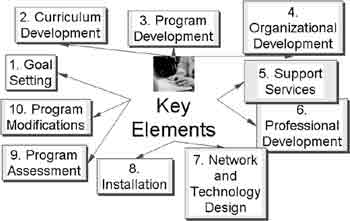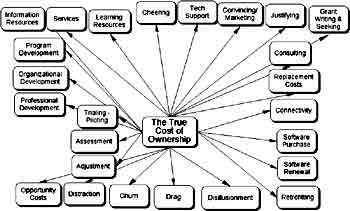|
|
| Vol 12|No7|March|2003 | |
|
Please feel free to e-mail this article to a friend, a principal, a parent, a colleague, a teacher librarian, a college professor, a poet, a magician, a vendor, an artist, a juggler, a student, a news reporter or anyone you think might enjoy it. Other transmissions and duplications not permitted. (See copyright statement below).
When most schools and districts install networks, they are unlikely to appreciate fully the wide range of costs accompanying the installation. Some of these will be dollar costs. Some will be organizational and psychic. When major costs and impacts arrive unannounced and unanticipated, they may cause embarrassment and damage. It makes good sense to look ahead without rose-tinted glasses.
I. Learning Resources not Included with the Boxes Despite the huge expenditures required to fill classrooms with networked computers, most schools discover late in the game that these shining boxes are relatively empty shells and the free Internet proves seriously lacking as an educational resource. A. Subscription Information Resources While some school leaders expect the Internet to provide a free lunch of quality information sources, the so-called “free” Internet is seriously flawed and unreliable. Schools discover that critical categories such as biography and history are not reliably and consistently covered. They invariably end up paying substantial fees to subscribe to periodical collections and other digital resources to supplement what comes free of charge. They also come to see digital resources as a poor substitute for a well-designed print collection - the library. The costs of new digital resources mount while more traditional library expenses persist. In those cases where library collections are ignored, neglected and under funded, staff and students will find the search for truth severely compromised. B. Curriculum & Lesson Planning Services Because the Internet is quite disorganized and often frustrating, many schools end up paying for curriculum support services like Classroom Connect and Scholastic or educational portals of various kinds such as BigChalk.com. These services offer lesson plans and user interfaces that promise to convert the chaos of the Net into something comfortable, efficient and standards-based. C. Supplemental Learning Resources Many educators find themselves spending money on guidebooks, lesson packs, supplemental materials and printed matter to accompany the new technologies. Despite vague promises of paperless classrooms and digital schooling, the new technologies often fall short of these visions and fail (by themselves) to provoke or sustain learning that is vivid, engaging and effective. II. Organizational Impacts and Management It turns out that the health of the district, the effectiveness of the school and the productivity of the staff can be adversely influenced unless the introduction of the new program takes into account many organizational impacts such as the ones listed in this next section. A. Assessment In order to steer a program forward with good results, the team leading the innovation needs to collect data on a frequent basis. The data reveals which elements and strategies are working and which are failing. The data should cover everything from attitudes of staff and students to indicators of learning. If students are expected to work better in teams, the school should track development of those capabilities. If inferential reasoning and problem-solving are goals, measures of these capacities are critical. Those designing this assessment must be careful not to put too much focus on the wrong things, since the assessment tail may wag the program dog. While gathering data about the innovation, it also pays to monitor the climate of the school and district in more general terms. Indicators of general well-being and student productivity should be routinely checked to make sure the innovation is not having a negative impact elsewhere. In too many cases, the introduction of new technologies is approached as if such changes can only bring benefits. Stories of stress, turbulence, disappointment and disillusionment would argue otherwise. B. Adjustment Programs almost always need to be adapted to match local conditions and circumstances. Based on assessment data and actual experience, some elements are eliminated while others are intensified. Fine-tuning is an essential aspect of success. During this process, denial is a major trap to be overcome, as leaders may have invested so heavily in the innovation that they wish to hear nothing but stories of grand success. They may be prone to shoot the messenger bringing tales of sorrow or disappointment. Adjustment is unlikely to occur unless leaders with influence and good standing within the organization are charged with this responsibility, sheltered from risk and given healthy budgets to support the process. There must be a district or school planning process that institutionalizes and honors the invention process. C. Opportunity Costs Schools need to examine honestly what they will lose or pass up by implementing the new program. Perhaps the flow of funds and other resources into the new venture will starve existing projects or delay others that are deserving in their own right. If this starving and delaying is done consciously and intentionally, it is one thing, but if these consequences are unforeseen and ill-considered, the innovation may be guilty of distorting agendas and priorities - hogging the limelight and the lion’s share of scarce resources. As with the challenge of program adjustment, this kind of questioning and thinking is unlikely to occur in most places unless there is a formalized planning process and group that elevates risk assessment to a priority. Normal school operations are tinged with too much urgency and stress for personnel to address these issues during the course of daily management. The questions are only likely to surface in a productive and protective manner if they are handled within the deliberations of a planning group whose members have been trained to address doubts, risks and challenges. D. Churn Teachers need some stability and predictability to meet the needs of young people. Too much change in the basic rhythms and routines of daily practice can throw teachers off balance and weaken their effectiveness. When the demands of the new new thing (The New New Thing: A Silicon Valley Story by Michael Lewis, W.W. Norton & Company, 1999) run counter to their prime mission - the nurturing of student performance - the broad range of goals is likely to suffer. Much as proponents of change enjoy metaphors of white-water rafting and turbulence, most classroom teachers require something quite different. Ironically, classrooms are more likely to change when there is a degree of stability. E. Drag New programs can place extraordinary demands upon the system and slow down progress in other areas as the innovation requires a disproportionate share of resources just to get off the ground. Planners too often focus on the new without considering how it might impact what preexisted. New gains may entail old losses, as the new new thing may inspire preoccupation and neglect. F. Disillusionment Because new programs almost always demand a high level of persuasion to convince folks to climb on board, there is a good chance that the reality will fail to meet the high expectations created by the hype and promotion. Broken promises and broken dreams make for a long-standing reluctance to invest in future ventures. G. Distraction There is some danger that the innovation will sidetrack, derail and delay the primary business of the school as everybody tries to launch the exceptional at the expense of the normal. III. Network Management & Development A. Consulting The complexity of the networking challenge puts many school districts in an awkward position. Because the innovation is relatively new, it is unlikely the district will possess strong internal resources to guide the process. One solution is to hire outsiders to work as district employees, but this solution is rarely sufficient, as the scale and complexity of the challenge is still likely to be grander than what can be handled by the type of person the district may be able to afford. Smart districts will maintain consulting relationships with outsiders that allow triangulation of advice - the comparing and contrasting of strategies without developing major dependencies. The trick is to create advisory relationships without conflicts of interest or dependencies. B. Connectivity The more that staff and students make use of a network, the greater the bandwidth required to support robust use. Unfortunately, many districts are penny wise and pound-foolish when it comes to bandwidth, falling into the 11:00 AM trap. For some reason, student and staff use often peaks at late morning, resulting in such heavy traffic on the network that it is virtually impossible to reach any site on the Internet with acceptable speed. Many schools under fund the connectivity to such an extent that they end up with “virtual Internet.” C. Tech Support In the business world, standards for technician support levels usually call for one technician for every 50-75 users. (See CoSN report on support levels) In school districts, there may be only one technician for every 300-500 desktops. This lack of staffing usually leads to an unstable network, a backlog of malfunctioning desktops and much frustration for end users. Understaffing also chokes off the development of many network services such as storage, e-mail and the provision of information services as crisis management (putting out fires) becomes the main focus of activity. Network starvation occurs when IT departments do not have enough staff to support robust network functions. (“Network Starvation” – From Now On, February 2000 - http://fno.org/feb2000/starvation.html IV. Network Resources A. Software Purchase In some respects, new technologies are empty shells, taking on power and value only as software programs are added to match the tasks that must be completed. Once the budget is expended for hardware, many districts find themselves without the funds to add a rich assortment of software tools to the computers. Many computers come bundled with basic software that must suffice for financial reasons. The software resides on the computers because it was bundled, not because it was chosen to match school objectives. To optimize educational use, a full array of curriculum-related software tools should be available for staff and student use. B. Software Renewal While software bundles may seem cheap, licenses often expire after a few years, requiring huge expenditures rarely anticipated or included in budgets. Networks change the debate over software piracy as vendors find it increasingly easy to monitor compliance and impose fines for violations. Maintaining current software licenses turns out to be costly. C. Replacement Costs Few districts have any real sense of the pace (and the price) of obsolescence. Advances and changes in network and system software mean that most computers cannot survive much longer than 36 months. Few replacement budgets match reality. This phenomenon either leads to rust or unanticipated spending lurches. D. Retrofitting Many of the existing infrastructures (both technical and human) will need to be upgraded to support the new systems and new experiences arriving upon the scene. Electrical capacity may be insufficient. Certain human capacities may need augmentation - collaboration, inventiveness and flexibility. Too many assume that transplants may be executed without preparation. V. Research & Development A. Program Development Given the highly unorganized and unreliable nature of the Internet, success requires the creation of learning experiences that match local curriculum and preferences. The district must either buy or create unit and lesson plans that convert the Net into something useful. In order to see widespread use of these units, the district should be engaging teachers in both the construction and the testing of curriculum units, pilot testing them to make sure they are worthy. Once they have proven worthwhile, they should be incorporated into district curriculum documents as required activities and should be supported by appropriate professional development programs designed to equip teachers with the skills they will need to implement the units effectively. B. Professional Development Few teachers are naturally equipped to make productive use of new technologies. They often require 50-100 hours of intensive adult learning to grasp the potential of new technologies to transform student learning. Very few districts are equipped to offer much more than software training, a trap that reduces the chance of making an impact upon daily classroom practice. We now know that many teachers may require as much as 30-90 hours of curriculum-rich learning and unit building to achieve a high level of success with new technologies. The design of successful adult learning programs is fully described in the September 2002 issue of Multimedia Schools, “Beyond Toolishness: The Best Ways for Teachers to Learn and Put New Technologies to Good Use.” C. Organizational Development Some of the most promising change strategies require informal support networks that surround teachers with skilled and willing partners who can ease the path from disengagement to productive use. Creating a culture of support, encouragement, collaboration and trust is no simple task. D. Trialing - Piloting In the rush to network rapidly, most school districts ignored a long-standing tradition of piloting major new programs in a small way before making a major commitment. Pilot programs allow decision-makers to figure out which innovations are likely to succeed and pay real returns on investments without making much of a commitment up front. It is a wise, discerning strategy that protects all from wild speculation and lurching. In the next decade, as the exuberance of the dotcom era passes, some of these time-tested strategies will regain popularity and return to common usage. Schools will be far less likely to adopt sweeping changes without seeing greater evidence of value up front. VI. Spirit & Support Building A. Cheering Blending new programs and tools into daily appropriate classroom use involves considerable risk and stress on the part of teachers implementing the changes. To sustain such risk-taking and such innovative behavior, leaders and participants alike must engage in morale building activities to keep everybody on the team feeling good about the change process. These activities require a substantial investment of time, energy and talent. Among other tasks, team members must monitor attitudes and moods frequently and periodically to make sure that bad feelings are kept from growing, spreading and contaminating the project. B. Convincing/Marketing All stakeholders must have a chance to consider and then applaud the wisdom of the innovation. To take any of this support for granted is dangerous. To assume that persuasion is not required is flirting with imposition and rejection. An energetic and full launch requires active, purposeful recruitment of all whose endorsement and approval will be required to achieve lift off. There should be no confusion or doubt about why the innovation is being introduced. C. Justifying Once the district commits major resources to an innovation, a good deal of energy must go into the public relations effort required to convince all investors that it was a wise move. “It goes without saying,” is a suicidal strategy, as skeptics and cheerleaders alike wish to know that their predictions proved true. D. Grant Writing & Seeking Funding innovation sometimes requires extensive investment in often frustrating grant seeking behaviors as operating funds may not be adequate to support bold new ventures. Unfortunately, the grant seeking may be more hit than miss, requiring hundreds of hours of activity not easily translated into real benefits for classrooms and the program. In other cases, as documented in a study by Means, et. al., (The Connected School: Technology and Learning in High School, Jossey-Bass, 2001) successful grants may support only a short-term burst of innovation rather than sustained program development. A sudden infusion of funds without long-term prospects for ongoing support may distort district priorities without making enduring changes. Anticipating the True Cost of Ownership Given the extensive list of costs outlined in this chapter, what can a school or district do to make sure the plan of action is complete? The first step, of course, is to promote awareness across all stakeholder groups of these extensive costs and responsibilities. Unless they have been through such an implementation previously, many of these participants may be surprised by the contents of this chapter. Once awareness is achieved, the next step is to create a budget for the project that identifies all costs, whether they show as up as dollar figures or as costs that are felt in more subtle ways. For each of these costs there must be resources allocated or plans prepared to make sure costs do not become barriers or serious flaws in the adoption. A district that employs a planning model similar to the one introduced at the beginning of this chapter will find that many of the costs outlined here will be addressed within the context of curriculum planning - a healthy and welcome approach. |
|
Back to March Cover
Credits: The photographs were shot by Jamie McKenzie .
Copyright Policy: Materials published in From Now On may be duplicated in hard copy format if unchanged in format and content for educational, nonprofit school district and university use only and may also be sent from person to person by e-mail. This copyright statement must be included. All other uses, transmissions and duplications are prohibited unless permission is granted expressly. Showing these pages remotely through frames is not permitted.
FNO is applying for formal copyright registration for articles. Unauthorized abridgements are illegal.
|
 From Now On
From Now On

